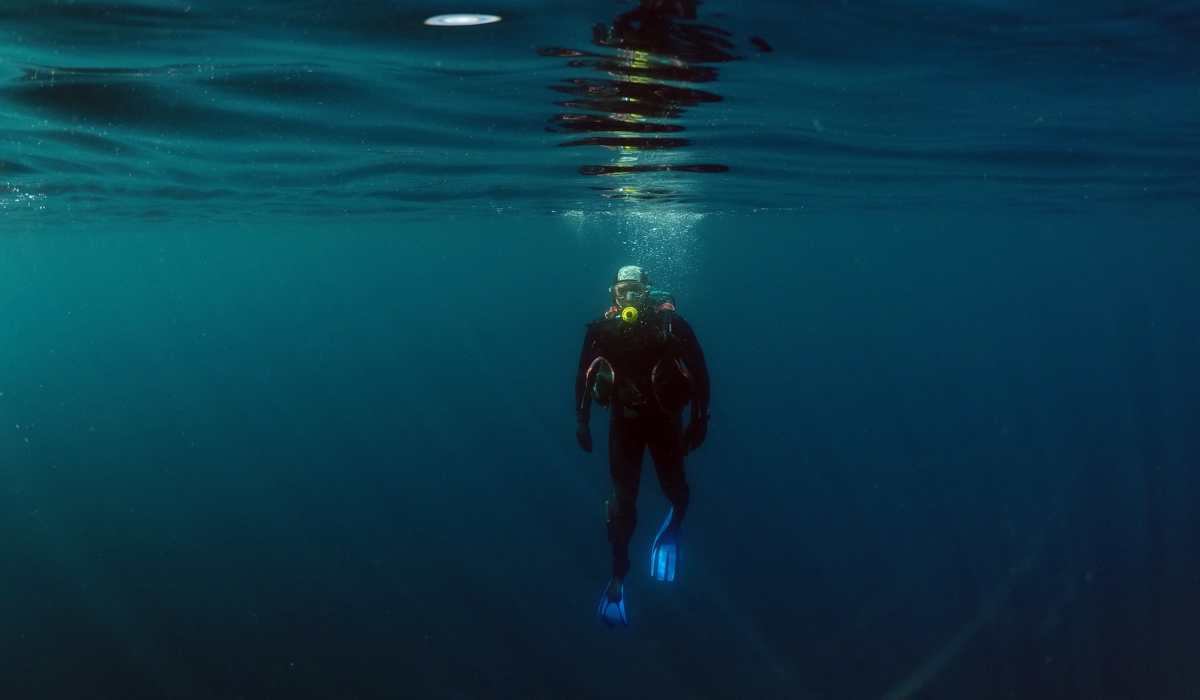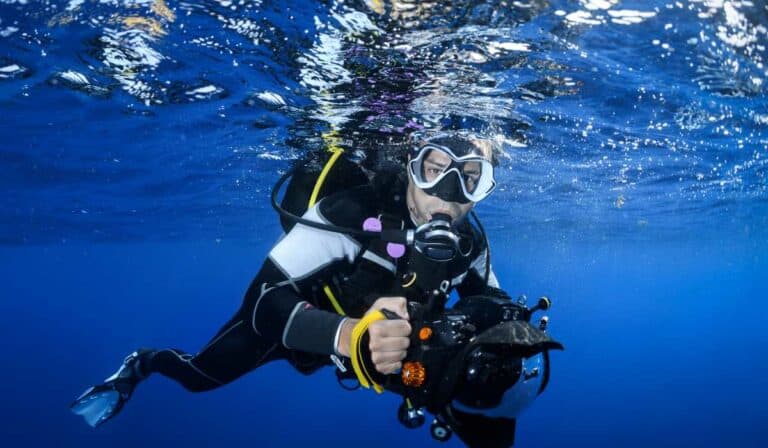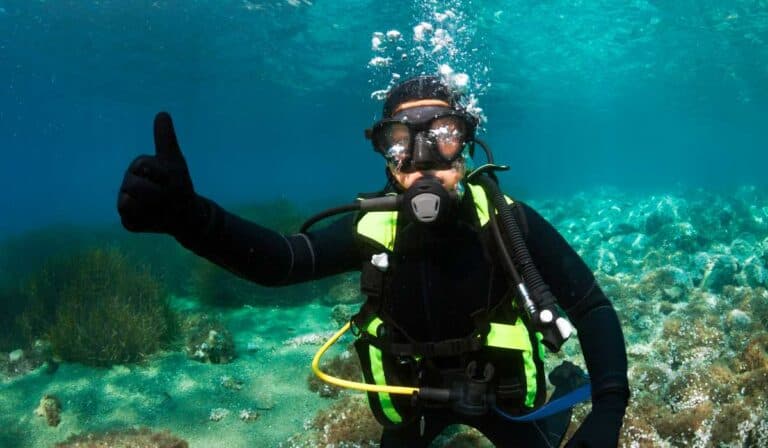Best Rated Dive Lights for Scuba Diving
To ensure a superior underwater experience, it is important to consider the best-rated dive lights for scuba diving. Dive lights play a crucial role in illuminating the mysterious and captivating underwater world during night dives, wreck diving, or simply exploring dark crevices.
In this comprehensive guide, we will explore various types of dive lights such as LED and halogen options. We’ll also discuss some of the best-rated dive lights for scuba diving currently available on the market along with their features and benefits.
Battery life is an important aspect when choosing a good dive light; therefore, we will provide insights into what you should look out for regarding battery performance. Additionally, maintenance and care tips will be shared to ensure that your chosen scuba light remains functional over time.
Last but not least, safety precautions are paramount while using these powerful devices underwater. Read on as we delve deeper into each topic to help you make an informed decision about which dive light suits your needs perfectly.
Table of Contents
1. Overview of Dive Lights

Dive lights are an essential piece of equipment for scuba divers, providing visibility and safety during underwater exploration. They come in various types, each with unique features and benefits tailored to different diving conditions and preferences. This section will look at the different types of dive lights available, highlighting their distinctive features and advantages for various diving scenarios.
Primary vs Secondary Dive Lights
Primary dive lights are designed to be your primary source of illumination during nighttime or low-visibility dives. These powerful lights usually have a longer battery life and higher lumen output compared to secondary dive lights. Primary dive lights can either be handheld or mounted on your wrist or BCD (Buoyancy Control Device).
Secondary dive lights, also known as backup or emergency dive lights, serve as a backup light source if your primary light fails during a dive. These compact and lightweight devices typically have lower lumen output but still provide enough brightness for basic navigation in case of emergencies.
Click here to read about 7 Best Places for Scuba Diving in the USA
Main Types of Dive Light Bulbs: LED vs Halogen
The two most common bulb types used in modern-day scuba diving flashlights are LED (Light Emitting Diode) and halogen bulbs. Comparing their respective pros and cons, we will explore each type of bulb further in the following sections.
- LED Dive Lights: Known for their energy efficiency, durability, long lifespan, and high brightness levels; LED is now the preferred choice among many divers due to these advantages over traditional halogen bulbs.
- Halogens: Although less popular than LEDs, halogen dive lights still have their place in the diving world. They produce a warmer light and can be more affordable than LED models; however, they are less energy-efficient and may require more frequent bulb replacements.
Beam Angle: Spot vs Flood Lights
Dive lights also vary in terms of beam angle, which determines how wide or narrow the light’s focus is underwater. The two main categories include:
- Spotlights (Narrow Beam): These dive lights emit a concentrated beam of light that penetrates further into the water column, making them ideal for exploring crevices or illuminating specific objects at greater distances.
- Floodlights (Wide Beam): With a broader coverage area compared to spotlights, floodlights provide excellent overall illumination during dives but do not penetrate as far into the water due to their wider dispersion pattern. They are perfect for underwater photography and videography where even lighting is essential.
In addition to these primary types of dive lights, there are also specialized options such as strobe lights used for signaling purposes and UV (Ultraviolet) dive lights designed specifically for fluorescence night diving experiences.
Selecting the right type of scuba diving flashlight depends on your individual needs and preferences – whether you prioritize brightness levels, battery life efficiency, or affordability. In this guide, we will delve deeper into each category while highlighting some top-rated brands available today.
The Overview of Dive Lights section provides a comprehensive overview of the different types and uses of dive lights. LED Dive Lights offer improved performance, brightness, and battery life compared to traditional incandescent models; let’s take a closer look at these features in the next heading.
Key Takeaway:
Dive lights are crucial for scuba divers to ensure visibility and safety underwater. Primary dive lights provide a powerful source of illumination, while secondary dive lights serve as backups in case of emergencies. LED is the preferred bulb type due to its energy efficiency, durability, and high brightness levels over halogen bulbs.
2. LED Dive Lights
Dive lights have come a long way in recent years, and one of the most popular types on the market today is the LED dive light. These energy-efficient, powerful lights are perfect for scuba diving enthusiasts who want to explore underwater worlds with ease. In this section, we’ll examine the features and benefits of LED dive lights compared to other types.
Advantages of LED Dive Lights
- Brightness: LEDs produce bright white light that can penetrate through murky waters better than traditional halogen bulbs. This makes it easier for divers to see their surroundings clearly while exploring underwater environments.
- Energy Efficiency: One major advantage of using an LED dive light is its energy efficiency. They consume less power than halogen or incandescent bulbs which means longer battery life and fewer battery replacements over time.
- Durability: LEDs are known for their durability as they don’t have fragile filaments like traditional bulbs do. This makes them more resistant to damage from drops or impacts during dives.
- Lifespan: The average lifespan of an LED bulb is around 50,000 hours – much longer than halogen or incandescent options which typically last between 1,000-5,000 hours depending on usage patterns.
Disadvantages of LED Dive Lights
- Color Rendering Index (CRI): A potential downside to LED dive lights is their lower CRI compared to halogen bulbs. This means that colors may appear more washed out or less vibrant underwater when using an LED light source.
- Initial Cost: While the long-term savings of using an LED dive light can be significant, they do tend to have a higher upfront cost compared to halogen or incandescent options. However, many divers find that the benefits outweigh this initial investment over time.
In summary, LED dive lights offer numerous advantages for scuba diving enthusiasts looking for a reliable and efficient lighting solution. With their bright output, energy efficiency, durability, and long lifespan – it’s no wonder these lights are becoming increasingly popular among divers worldwide. If you’re in search of a high-quality underwater lighting option with minimal drawbacks, consider investing in an LED dive light.
Click here to read about 5 Best Places for Scuba Diving in Europe
LED dive lights are a great choice for underwater exploration, providing bright illumination and long battery life. Halogen dive lights offer a greater intensity of light but at the cost of shorter battery life compared to LED models.
Key Takeaway:
LED dive lights are favored amongst scuba divers due to their intense luminosity, energy efficiency, resilience, and extended life. However, they may have a lower color rendering index compared to halogen bulbs and come with a higher initial cost. Overall, LED dive lights offer numerous advantages that outweigh the drawbacks for those looking for a reliable and efficient lighting solution underwater.
3. Halogen Dive Lights

When it comes to choosing the right dive light for your underwater adventures, you might find yourself comparing halogen and LED options. In this section, we’ll delve into the world of halogen dive lights, highlighting their pros and cons compared to their LED counterparts.
Pros of Halogen Dive Lights
- Brighter Light: One major advantage of halogen dive lights is that they produce a brighter and more focused beam than most LEDs. This can be particularly useful when exploring deeper or darker waters where visibility is limited.
- Natural Color Rendering: Unlike some LEDs which may have a bluish tint, halogens offer more natural color rendering underwater. This means that colors appear truer to life, allowing you to better appreciate the beauty of marine life and coral reefs during your dives.
- Affordability: While prices vary depending on brand and features, in general, halogen dive lights tend to be less expensive than high-quality LED models. For budget-conscious divers looking for an affordable yet powerful option, a halogen light might just fit the bill.
Cons of Halogen Dive Lights
- Poor Energy Efficiency: The biggest drawback of using a halogen light is its poor energy efficiency compared to an LED alternative. They consume more power while producing less overall brightness per wattage used – meaning shorter battery life and potentially higher long-term costs due to frequent battery replacements.
Halogen dive lights provide a powerful beam of light that can be used for both recreational and professional diving. Moving on, the next heading will discuss some of the best-rated dive lights available today.
4. Best Rated Dive Lights for Scuba Diving
Dive lights are essential for enhancing your underwater experience, whether you’re exploring a deep cave or simply admiring the vibrant marine life during a night dive. Choosing the right dive light that meets all your needs and fits within your budget can be a difficult task. To help make this decision easier, we’ve compiled a list of some of the best-rated dive lights currently available.
1. OrcaTorch D520 Scuba Dive Light
The OrcaTorch D520 is an excellent choice for divers seeking a compact yet powerful LED dive light. It boasts 1000 lumens output with up to 150 meters beam distance and has three hours of runtime on its rechargeable battery. The aircraft-grade aluminum alloy body ensures durability while remaining lightweight at just 113 grams without batteries. This versatile torch also features an easy-to-use rotary switch design that allows one-handed operation even when wearing thick gloves.
- Pros: Compact size, durable construction, long runtime
- Cons: No adjustable brightness settings
- Estimated Price: $69-$89 USD
2. Bigblue AL1200NP Wide Beam Dive Light
If you’re looking for something more advanced with customizable settings, consider investing in the Bigblue AL1200NP Wide Beam Dive Light. This impressive device offers four levels of brightness (up to 1200 lumens), as well as an SOS mode for emergencies. The wide 85-degree beam angle is perfect for illuminating large areas, and the light’s burn time ranges from two to twenty hours depending on the brightness setting used. The device boasts a depth rating of up to one hundred meters, allowing it to be used in deep-water scenarios.
- Pros: Multiple brightness settings, long runtime, wide beam angle
- Cons: Slightly bulkier than some other options
- Estimated Price: $139-$159 USD
3. Light & Motion SOLA Dive 1200 S/F Light
The Light & Motion SOLA Dive 1200 S/F Light, while more expensive than some alternatives, offers excellent performance and versatility in one compact package. With both spot (12°) and flood (60°) beams available at the touch of a button, this dive light can adapt to various underwater conditions with ease. Its maximum output reaches an impressive 1200 lumens with three power levels plus SOS mode available. The rechargeable battery supplies up to three hours of illumination on maximum power.
- Pros: Dual-beam functionality, multiple brightness settings, compact design
- Cons: Pricier option compared to others on this list
- Estimated Price: $299-$349 USD
These are just a few examples of top-rated dive lights that cater to different preferences and budgets. No matter which models you choose, always prioritize safety features, durability, and ease of use to ensure a smooth diving experience.
Dive lights are an essential part of a diver’s gear and can make or break the experience. When considering which dive light to purchase, battery life should be taken into account as it is critical for safety in any underwater situation.
Key Takeaway:
Looking for the best dive lights for scuba diving? Check out these top-rated options: OrcaTorch D520 Scuba Dive Light, Bigblue AL1200NP Wide Beam Dive Light, and Light & Motion SOLA Dive 1200 S/F Light. Consider factors such as brightness settings, runtime, durability, and ease of use when choosing your ideal dive light.
5. Battery Life Considerations

When selecting a dive light for your underwater adventures, it’s essential to consider the battery life of different models. The runtime of a dive light can greatly impact your diving experience and overall safety during nighttime or deep dives. In this section, we’ll explore various factors that affect battery life and provide runtime estimates for some popular models.
Battery Types
Dive lights commonly utilize disposable alkaline batteries, rechargeable NiMH cells, or Li-ion power sources. Each type has its own advantages and disadvantages:
- Alkaline Batteries: These are inexpensive and widely available but offer shorter runtimes compared to other options.
- NiMH Batteries: Rechargeable NiMH batteries have longer lifespans than alkalines but may require more frequent charging due to their lower energy density.
- Lithium-Ion Batteries: Li-ion batteries provide the longest runtimes among all three types; however, they tend to be more expensive initially.
Click here to read about A Guide To Scuba Diving in Honduras
Affected Factors & Runtime Estimates
The runtime of a dive light depends on several factors such as its power output (measured in lumens), battery capacity, and usage habits. Generally speaking, higher lumen outputs will drain the battery faster while larger capacities will extend the runtime. Here are some estimated runtimes for popular dive lights based on their specifications:
When deciding on a dive light, battery life is an essential factor to consider as it dictates the length of your underwater exploration. To ensure that your dive light remains in good condition and continues working properly, proper maintenance and care are essential; this topic will be discussed further in the next heading.
6. Maintenance & Care Tips
Taking proper care of your dive light is essential to ensure its longevity and optimal performance during your underwater adventures. By following these maintenance and care tips, you can keep your dive light in excellent condition for years to come.
Rinse with Fresh Water After Each Dive
After each dive, make sure to rinse your dive light thoroughly with fresh water. This will help remove any saltwater residue or debris that may have accumulated on the surface of the device. Saltwater can be corrosive and cause damage over time if not properly cleaned off.
Check O-Rings Regularly
The O-rings are crucial components of a waterproof seal in most dive lights, ensuring that no water enters the battery compartment or other sensitive areas within the device. Inspect them regularly for signs of wear or damage, such as cracks or nicks, which could compromise their effectiveness at keeping water out.
- If you notice any issues with an O-ring, replace it immediately before using the light again.
- Lubricate O-rings periodically using silicone grease specifically designed for this purpose – avoid petroleum-based products as they can degrade rubber materials over time.
- Clean O-ring grooves carefully when replacing them to ensure a proper seal upon reassembly.
Store Your Dive Light Properly Between Dives
To prevent accidental activation while stored away between dives (which could drain batteries), always store your dive light with either:
- The battery removed
- Or the switch is locked, if your dive light has a lockable switch feature.
Additionally, store your dive light in a cool and dry place away from direct sunlight or heat sources. Store your dive light in a cool, dry area away from direct sunlight and heat to protect the batteries and other components.
Monitor Battery Life & Replace When Necessary
Keep track of how long you have been using your dive light’s batteries – over time, their performance may degrade due to repeated charging cycles or simply age. If you notice that your dive light is not lasting as long during dives as it once did, consider replacing its batteries with fresh ones for optimal performance.
Regularly Inspect Your Dive Light for Damage
Last, but not least, make sure to regularly inspect your entire dive light unit for any signs of wear or damage such as cracks in the housing or frayed wires near switches/connectors. If you find any issues like these, address them immediately by either repairing them yourself (if possible) or seeking professional assistance at a local scuba gear shop.
By following these maintenance and care tips diligently, you can ensure that your trusty underwater illumination companion remains reliable throughout countless dives.
Maintaining and caring for your dive light is essential to ensuring it works properly during dives. For a secure scuba diving adventure, it is imperative to be aware of the safeguards connected with using dive lights.
Key Takeaway:
To keep your dive light in excellent condition for years to come, rinse it with fresh water after each dive, check O-rings regularly, and store it properly between dives. Monitor battery life and replace when necessary, as over time their performance may degrade due to repeated charging cycles or simply age. Regularly inspect the entire unit for any signs of wear or damage such as cracks in the housing or frayed wires near switches/connectors.
Click here to read about Discover the 5 Best Beach Cities for Scuba Diving
7. Safety Precautions

When it comes to scuba diving, safety should always be a top priority. This is especially true when using dive lights underwater, as improper use can lead to accidents or injuries. To ensure a safe dive experience, it is essential to take into consideration the safety precautions related to using dive lights.
Avoid Direct Contact with Eyes and Skin
Dive lights are designed to provide bright illumination for better visibility underwater. The intense light of dive lights can be hazardous if it comes into contact with the eyes or skin. To avoid potential harm:
- Never look directly into the beam of your dive light.
- Avoid shining the light on another diver’s face mask or bare skin.
- If you need to signal another diver using your light, shine it onto an open palm and wave gently back and forth rather than pointing it directly at them.
Maintain a Safe Distance from Marine Life
The bright beams emitted by dive lights can also have adverse effects on marine life if used improperly. Some animals may become disoriented or stressed when exposed to intense artificial lighting. To minimize any negative impact on aquatic creatures:
- Keep a respectful distance from marine life while using your dive light.
- Aim the beam away from sensitive species like turtles and corals whenever possible.
Battery Safety Tips
Your dive light’s battery is essential for powering its performance but mishandling batteries can result in dangerous situations such as leaks or even explosions. To ensure the safe usage of batteries during dives:
- Always follow manufacturer guidelines regarding charging times and battery replacement.
- Inspect your batteries regularly for signs of damage or corrosion, and replace them as needed.
- Avoid using damaged or leaking batteries in your dive light.
Be Aware of Your Surroundings
While a dive light can greatly enhance underwater visibility, it’s crucial to remain aware of your surroundings at all times. This includes being mindful of other divers, potential hazards like sharp rocks or entanglements, and any changes in water conditions that may affect visibility. To stay safe during dives:
- Maintain communication with your dive buddy through hand signals or other agreed-upon methods.
- Regularly check in on each other’s well-being throughout the dive.
Prioritizing safety is key to having a great time when diving, so make sure you and your dive buddy are communicating effectively and checking in on each other’s wellbeing. Remember to always prioritize safety when using a dive light, so you can focus on exploring the wonders beneath the waves without worry.
Click here to read about Diving in the Lone Star State: The Best Places to Scuba Dive in Texas
Key Takeaway:
Prioritizing safety is key when diving with a light source; be mindful of eyes and skin exposure, keep your distance from aquatic life, adhere to battery precautions, and stay aware of your environment. Avoid direct contact with eyes and skin, maintain a safe distance from marine life, follow battery safety tips, and be aware of your surroundings to ensure an enjoyable diving experience for everyone involved.
FAQs about Best Rated Dive Lights for Scuba Diving
What is the Best Light for Diving?
The best light for diving depends on your specific needs and preferences. However, LED dive lights are popular due to their energy efficiency, brightness, and durability. Some top-rated options include the ScubaPro Nova 720R Wide, Bigblue VL10000P II, and Light & Motion Sola Dive 1200 S/F.
HOW MANY LUMENS IS GOOD FOR A DIVE LIGHT?
A good dive light should have at least 500 lumens for recreational diving. For technical or cave diving, a minimum of 1,000 lumens is recommended. Keep in mind that higher lumen output provides better visibility but may also consume more battery life.
What Color Light is Best for Diving?
A white LED light with a color temperature between 5,000K and 6,500K offers the most natural illumination underwater. This range helps reveal the true colors of marine life while providing sufficient brightness during dives.
WHAT IS THE BEST BATTERY FOR A DIVE FLASHLIGHT?
The best batteries for dive flashlights are rechargeable lithium-ion (Li-ion) or lithium-polymer (LiPo) batteries because they offer high energy density and long-lasting performance. Always choose quality branded batteries from reputable manufacturers to ensure safety and reliability during your dives.
Conclusion
Overall, dive lights are an essential tool for scuba divers, especially for those who enjoy night diving or underwater photography. LED dive lights and halogen dive lights are the two most common types of dive lights available on the market today. When selecting a dive light, aspects such as battery life, upkeep demands, and safety measures should be taken into account.
If you’re looking for the best-rated dive lights for scuba diving, be sure to check out our recommendations in section 4 above. Remember that proper care and maintenance can help extend the lifespan of your dive light and ensure that it works properly when you need it most.







